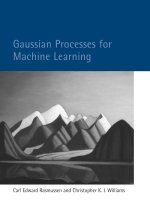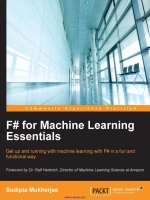Linear algebra for machine learning
Bạn đang xem bản rút gọn của tài liệu. Xem và tải ngay bản đầy đủ của tài liệu tại đây (4.11 MB, 62 trang )
Machine Learning
Srihari
Linear Algebra for Machine
Learning
Sargur N. Srihari
1
Machine Learning
Srihari
What is linear algebra?
• Linear algebra is the branch of mathematics
concerning linear equations such as
a1x1+…..+anxn=b
– In vector notation we say aTx=b
– Called a linear transformation of x
• Linear algebra is fundamental to geometry, for
defining objects such as lines, planes, rotations
Linear equation a1x1+…..+anxn=b
defines a plane in (x1,..,xn) space
Straight lines define common solutions
to equations
2
Machine Learning
Srihari
Why do we need to know it?
• Linear Algebra is used throughout engineering
– Because it is based on continuous math rather than
discrete math
• Computer scientists have little experience with it
• Essential for understanding ML algorithms
– E.g., We convert input vectors (x1,..,xn) into outputs
by a series of linear transformations
• Here we discuss:
– Concepts of linear algebra needed for ML
– Omit other aspects of linear algebra
3
Machine Learning
Linear Algebra Topics
– Scalars, Vectors, Matrices and Tensors
– Multiplying Matrices and Vectors
– Identity and Inverse Matrices
– Linear Dependence and Span
– Norms
– Special kinds of matrices and vectors
– Eigendecomposition
– Singular value decomposition
– The Moore Penrose pseudoinverse
– The trace operator
– The determinant
– Ex: principal components analysis
Srihari
4
Machine Learning
Srihari
Scalar
• Single number
– In contrast to other objects in linear algebra,
which are usually arrays of numbers
• Represented in lower-case italic x
– They can be real-valued or be integers
• E.g., let x ∈! be the slope of the line
– Defining a real-valued scalar
• E.g., let n ∈! be the number of units
– Defining a natural number scalar
5
Machine Learning
Vector
Srihari
• An array of numbers arranged in order
• Each no. identified by an index
• Written in lower-case bold such as x
– its elements are in italics lower case, subscripted
⎡ x
⎢ 1
⎢ x2
⎢
x=⎢
⎢
⎢
⎢ xn
⎢⎣
⎤
⎥
⎥
⎥
⎥
⎥
⎥
⎥
⎥⎦
• If each element is in R then x is in Rn
• We can think of vectors as points in space
– Each element gives coordinate along an axis
6
Machine Learning
Matrices
Srihari
• 2-D array of numbers
– So each element identified by two indices
• Denoted by bold typeface A
– Elements indicated by name in italic but not bold
• A1,1 is the top left entry and Am,nis the bottom right entry
• We can identify nos in vertical column j by writing : for the
horizontal coordinate
• E.g., ⎡ A A ⎤
• Ai:
1,1
1,2
⎥
A= ⎢
⎢ A2,1 A2,2 ⎥
⎣
⎦
is ith row of A,
A:j is jth column of A
• If A has shape of height m and width n with
m×n
A
∈!
real-values then
7
Machine Learning
Srihari
Tensor
• Sometimes need an array with more than two
axes
– E.g., an RGB color image has three axes
• A tensor is an array of numbers arranged on a
regular grid with variable number of axes
– See figure next
• Denote a tensor with this bold typeface: A
• Element (i,j,k) of tensor denoted by Ai,j,k
8
Machine Learning
Srihari
Shapes of Tensors
9
Machine Learning
Srihari
Transpose of a Matrix
• An important operation on matrices
• The transpose of a matrix A is denoted as AT
• Defined as
(AT)i,j=Aj,i
– The mirror image across a diagonal line
• Called the main diagonal , running down to the right
starting from upper left corner
⎡ A
⎢ 1,1
A = ⎢ A2,1
⎢
⎢ A3,1
⎣
A1,2
A2,2
A3,2
⎡ A
A1,3 ⎤
⎥
⎢ 1,1
T
A2,3 ⎥ ⇒ A = ⎢ A1,2
⎥
⎢
⎢ A1,3
A3,3 ⎥
⎦
⎣
A2,1
A2,2
A2,3
A3,1 ⎤
⎥
A3,2 ⎥
⎥
A3,3 ⎥
⎦
⎡ A
⎢ 1,1
A = ⎢ A2,1
⎢
⎢ A3,1
⎣
A1,2
A2,2
A3,2
⎤
⎡ A
⎥
⎢ 1,1
T
⎥⇒ A = ⎢ A
⎥
⎢ 1,2
⎥
⎢
⎣
⎦
A2,1
A2,2
A3,1 ⎤
⎥
A3,2 ⎥
⎥
⎥
⎦
10
Machine Learning
Srihari
Vectors as special case of matrix
• Vectors are matrices with a single column
• Often written in-line using transpose
x = [x1,..,xn]T
⎡ x
⎢ 1
⎢ x2
⎢
x=⎢
⎢
⎢
⎢ xn
⎢⎣
⎤
⎥
⎥
⎥
T
⎥ ⇒ x = ⎡⎣x 1 ,x 2 ,..x n ⎤⎦
⎥
⎥
⎥
⎥⎦
• A scalar is a matrix with one element
a=aT
11
Machine Learning
Srihari
Matrix Addition
• We can add matrices to each other if they have
the same shape, by adding corresponding
elements
– If A and B have same shape (height m, width n)
C = A+B ⇒C i,j = Ai,j +Bi,j
• A scalar can be added to a matrix or multiplied
by a scalar D = aB+c ⇒ D = aB +c
• Less conventional notation used in ML:
i,j
– Vector added to matrix
i,j
C = A+b ⇒C i,j = Ai,j +bj
• Called broadcasting since vector b added to each row of A
12
Machine Learning
Srihari
Multiplying Matrices
• For product C=AB to be defined, A has to have
the same no. of columns as the no. of rows of B
– If A is of shape mxn and B is of shape nxp then
matrix product C is of shape mxp
C = AB ⇒C i,j = ∑ Ai,k Bk,j
k
– Note that the standard product of two matrices is
not just the product of two individual elements
• Such a product does exist and is called the element-wise
product or the Hadamard product AÔB
13
Machine Learning
Srihari
Multiplying Vectors
• Dot product between two vectors x and y of
same dimensionality is the matrix product xTy
• We can think of matrix product C=AB as
computing Cij the dot product of row i of A and
column j of B
14
Machine Learning
Srihari
Matrix Product Properties
Distributivity over addition: A(B+C)=AB+AC
Associativity: A(BC)=(AB)C
Not commutative: AB=BA is not always true
Dot product between vectors is commutative:
xTy=yTx
• Transpose of a matrix product has a simple
form: (AB)T=BTAT
•
•
•
•
15
Machine Learning
Srihari
Example flow of tensors in ML
A linear classifier y= WxT+b
Vector x is converted
into vector y by
multiplying x by a matrix W
A linear classifier with bias eliminated y= WxT
Machine Learning
Srihari
Linear Transformation
ã Ax=b
where A ! nìn and b ∈! n
– More explicitly A x + A x +....+ A x = b
11 1
12 2
1n n
1
A21 x1 + A22 x2 +....+ A2n xn = b2
⎡ A
! A1,n
⎢ 1,1
A= ⎢ "
"
"
⎢ A
⎢ n,1 ! Ann
⎣
nxn
⎤
⎡ x ⎤
⎥
⎢ 1 ⎥
⎥ x = ⎢ " ⎥
⎥
⎢ x ⎥
⎥
⎢⎣ n ⎥⎦
⎦
nx1
n equations in
n unknowns
An1 x1 + Am2 x2 +....+ An,n xn = bn
⎡ b ⎤
⎢ 1 ⎥
b= ⎢ " ⎥
⎢ b ⎥
⎢⎣ n ⎥⎦
Can view A as a linear transformation
of vector x to vector b
n x1
• Sometimes we wish to solve for the unknowns
x ={x1,..,xn} when A and b provide constraints
17
Machine Learning
Srihari
Identity and Inverse Matrices
• Matrix inversion is a powerful tool to analytically
solve Ax=b
• Needs concept of Identity matrix
• Identity matrix does not change value of vector
when we multiply the vector by identity matrix
– Denote identity matrix that preserves n-dimensional
vectors as In
– Formally
and
In ∈! n×n
∀x ∈! n ,Inx = x
⎡ 1 0 0 ⎤
– Example of I3
⎢
⎥
0 1 0
⎢
⎥
⎢ 0 0 1 ⎥
⎦
⎣
18
Machine Learning
Srihari
Matrix Inverse
• Inverse of square matrix A defined as
• We can now solve Ax=b as follows:
A−1 A = In
Ax = b
A−1 Ax = A−1b
In x = A−1b
−1
x = A b
• This depends on being able to find A-1
• If A-1 exists there are several methods for
finding it
19
Machine Learning
Srihari
Solving Simultaneous equations
• Ax = b
where A is (M+1) x (M+1)
x is (M+1) x 1: set of weights to be determined
b is N x 1
20
Example: System of Linear
Equations in Linear Regression
Machine Learning
Srihari
• Instead of Ax=b
• We have Φw = t
– where Φ is m x n design matrix of m features for n
samples xj, j=1,..n
– w is weight vector of m values
– t is target values of sample, t=[t1,..tn]
– We need weight w to be used with m features to
determine output
m
y(x,w)=∑wi x i
i=1
21
Machine Learning
Srihari
Closed-form solutions
• Two closed-form solutions
1. Matrix inversion x=A-1b
2. Gaussian elimination
22
Machine Learning
Srihari
Linear Equations: Closed-Form Solutions
1. Matrix Formulation: Ax=b
Solution: x=A-1b
2. Gaussian Elimination
followed by back-substitution
L2-3L1àL2
L3-2L1àL3
-L2/4àL2
Machine Learning
Srihari
Disadvantage of closed-form solutions
• If A-1 exists, the same A-1 can be used for any
given b
– But A-1 cannot be represented with sufficient
precision
– It is not used in practice
• Gaussian elimination also has disadvantages
– numerical instability (division by small no.)
– O(n3) for n x n matrix
• Software solutions use value of b in finding x
– E.g., difference (derivative) between b and output is
24
used iteratively
Machine Learning
Srihari
How many solutions for Ax=b exist?
• System of equations with
A11 x1 + A12 x2 +....+ A1n xn = b1
A21 x1 + A22 x2 +....+ A2n xn = b2
– n variables and m equations is:
Am1 x1 + Am2 x2 +....+ Amn xn = bm
• Solution is x=A-1b
• In order for A-1 to exist Ax=b must have
exactly one solution for every value of b
– It is also possible for the system of equations to
have no solutions or an infinite no. of solutions for
some values of b
• It is not possible to have more than one but fewer than
infinitely many solutions
– If x and y are solutions then z=α x + (1-α) y is a
solution for any real α
25









